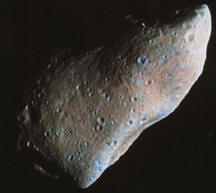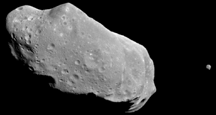|
         
> The Sun
> Mercury
> Venus
> Earth
> Mars
> Jupiter
> Saturn
> Uranus
> Neptune
> Pluto
> The 10th Planet?
> Asteroids
> Comets
> The 'Edge'
  
|
Most
asteroids are grouped in the asteroid belt, which is more like a loose
grouping than a belt, and lies between 2.5 and 4.5 A.U. (1 A.U. is the
average distance between Earth and the sun) from the sun - between the
orbits of Mars and Jupiter. The asteroids are so small and far away that
they appear as faint stars, if they even appear at all; no asteroid is
bright enough to be seen without some optical aid, except Ceres (see
below) on its closest approach. The asteroid belt is usually thought of as
a defined region where asteroids abound
(reference many science fiction movies, with spaceships flying in and out,
dodging debris). This is actually very unlike the asteroid belt -- the
region is so vast that asteroids are usually hundreds or thousands of
kilometers from their closest companion.

There are asteroids all over the solar system -- they are not just
confined to the belt. Their location does not dictate what they look like,
though; most of the larger asteroids look like Gaspra at the right.
Amors asteroids are those that cross Mars' orbit. Apollos are asteroids
that cross Earth's orbits, and are sometimes called "Earth Grazers." Atens
asteroids are those whose orbits lie completely inside of Earth's. There
are also asteroids on the other side of the belt. Centaur asteroids are
those that lie between 5.5 and 25 A.U. from the sun. Jupiter has its own
group of asteroids called Trojans; these follow Jupiter's orbit, and lie
both ahead and behind the planet in its path.
There are also many asteroids that gallivant around the solar system on
highly elliptical orbits like comets. Of note, the asteroid Icarus, when
closest to the sun, lies within Mercury's orbit. Hildago's closest
approach is between the orbit of Mars and Earth, and its farthest from the
sun between Saturn and Uranus.
What they are?
The first asteroid was discovered in 1801 by Giuseppe
Piazzi of Italy. He named it "Ceres" after the Roman goddess of grain.
Ceres is the largest known asteroid at approximately 950 km (590 miles),
and lies in the belt of asteroids between Mars and Jupiter, at an average distance from the sun of 3.5 A.U. Ever
since, asteroids have received an official designation of a number
(starting with Ceres of number "1"), and most larger ones have received a
name based in Roman mythology. If they have a name, then they are usually
referred to with the number then the name, such as 951 Gaspra. Currently,
asteroids are also referred to by the International Astronomical Union
(the only official body that can name astronomical objects) as minor
planets.
Asteroids range in size from dust particles to several miles across. Most
current theories hold that asteroids are bits of pieces left over from the
formation of the solar system. They are also formed from other asteroids
as they collide and break apart, as comets disintegrate, or even when the
outer moons of the larger planets collide. Past theories have suggested
that the asteroids are remnants of a planet that was destroyed early in
the solar system's history. However, that theory is no longer held in much
regard, for if all of the asteroids in the belt were combined, they would
form a body less than 1500 km (932 miles) in diameter -- less than half
the size of Earth's moon.
Asteroids are made of rock and metal. They are grouped into three
categories: Stony, Iron-Nickel, and a mixture of the two. Most asteroids
that we know about (92.8%) fall into the first category, and are made of
Silicates. 5.7% are Iron-Nickel. The balance form the third type. Despite
their relative abundance, stony asteroids that have fallen to Earth are
the hardest to find because they look like terrestrial rocks.
Asteroids have a confusing system of nomenclature, especially when they
are on Earth. While still in orbit, they are asteroids. Once they enter
the atmosphere, they are called meteors, and once they land, they are
termed meteorites. [Top]
Interesting facts and figures
Asteroids are too small to be spherical in shape. Instead,
they are usually ellipsoids, but some are dumbbell-shaped, and others form
even stranger ones. Asteroids bear the tale of the violence of the solar
system; the larger ones have many sizeable craters pockmarking their
surface.
One of the most surprising features of asteroids is that several have been
observed to have moons of their own. The first asteroid to be observed
with a moon was 243 Ida (58 x 23 km); it's moon is called Dactyl, and
measures approximately 0.75 x 0.87 x 1.0 miles. It is now estimated that
between 10-30% of asteroids have moons.
As previously stated, if all the asteroids in the belt were combined into
one, it would form a body less than 1500 km in diameter. Noting the
immense size of Ceres, it comprises over 1/3 the total suspected mass of
the belt (2.3 x 1021 kg).
26 known asteroids are larger than 200 km (124 miles). We probably know
99% of the asteroids that are greater than 100 km (62 miles), and there
are probably literally millions of asteroids that are greater than 1 km
(0.62 miles) in diameter. Over 10,000 asteroids have been found.
When asteroids break apart, the pieces don't always fly off in random
directions. Sometimes, they will continue in the same orbit as the
original asteroid. When several asteroids are seen in relatively the same
place and traveling along similar orbits, they are called orbital
families.
[Top] External Links
[Back] [Top] [Next] |

